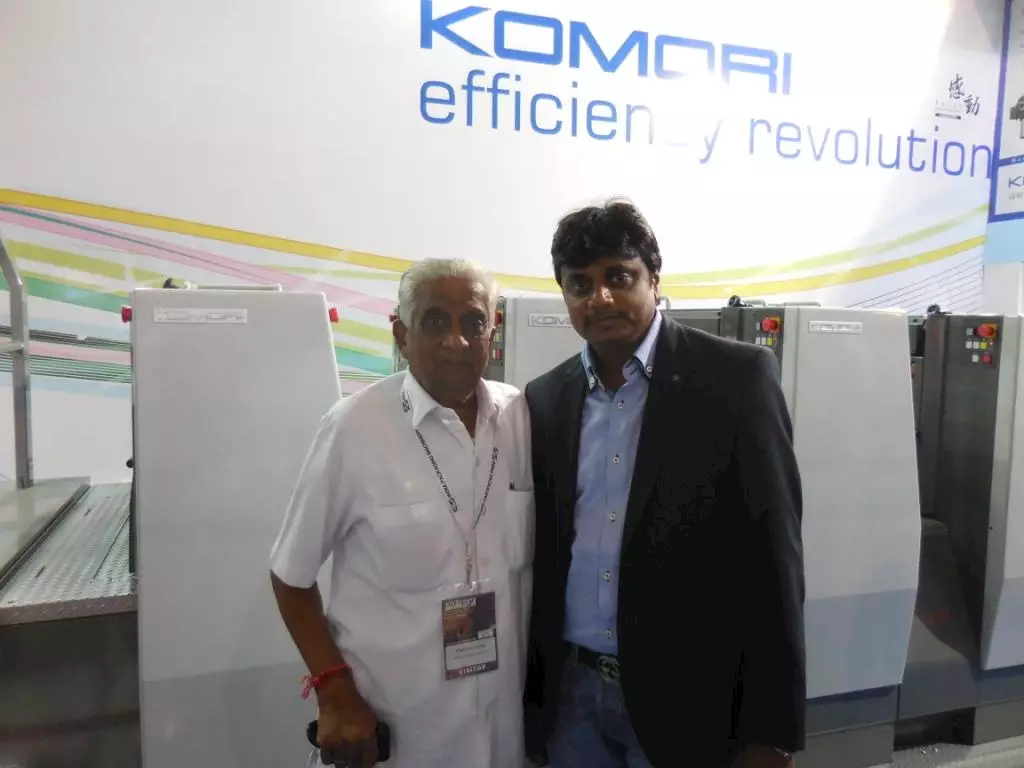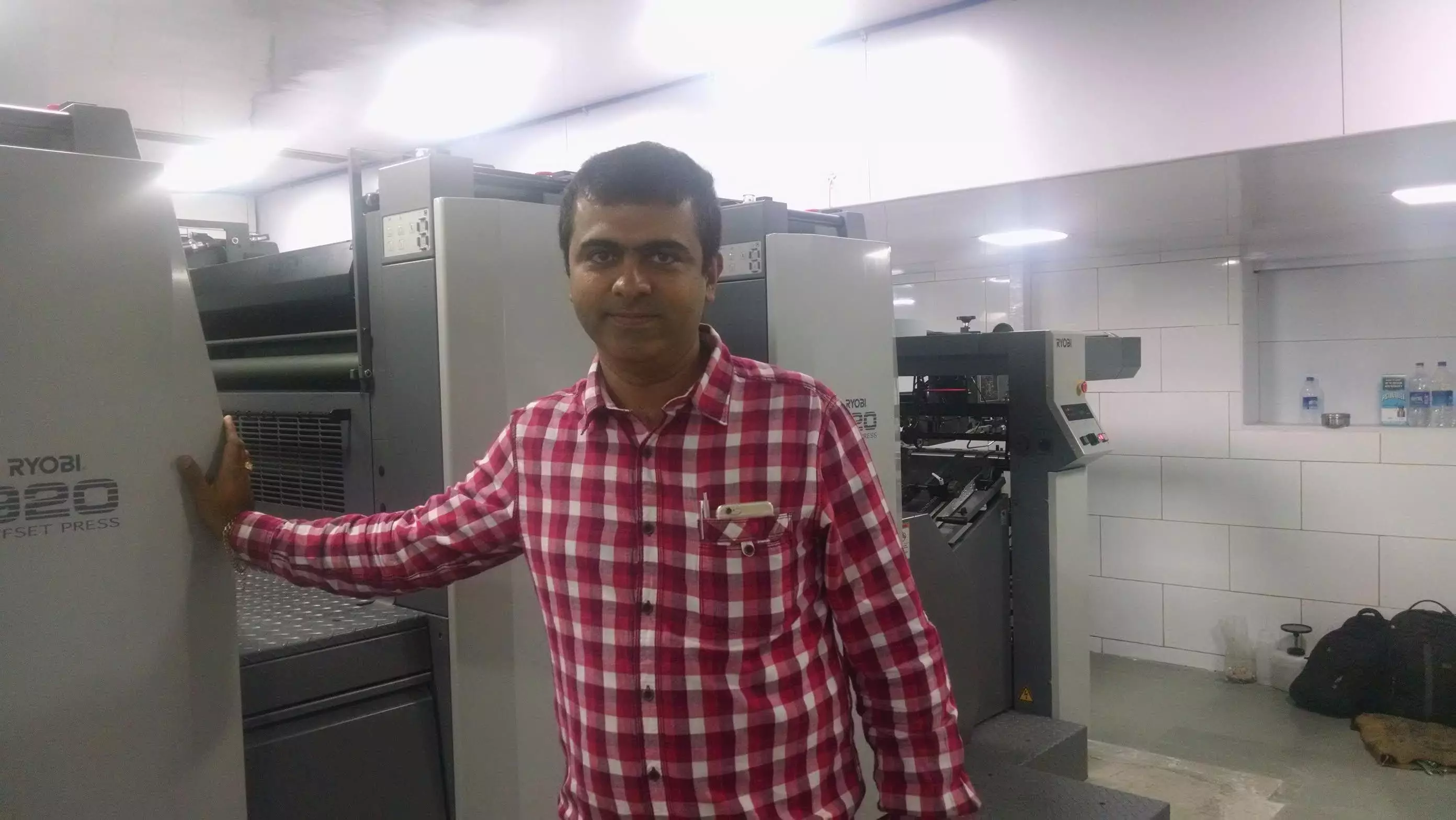By the end of 2015, our estimate is that around 70 new offset sheetfed printing presses, that is, around 340+ printing units would have come in. Rahul Kumar spoke to a few pre-owned industry experts and found out that the numbers more or less match that of last year. So if we consider a minimum ratio of 1:7 between new and pre-owned printing presses, that these industry experts quoted, we will have no less than 590+ pre-owned printing presses coming to India, which should be around 2,350+ units.
At Pamex 2015, one saw the Japanese manufacturers make a strong impact on the show. Komori’s Enthrone was the only imported press running live demos, while Provin Technos showcase the Ryobi presses.
But even though the value of presses may not be as high as the KBAs, the fact is that there is investment happening in the market. “That’s the interesting part of the Indian market story,” says Kaushal
Kaushal’s Provin, participating for the first time at a Pamex show enjoyed a successful first day during which it signed three orders for the Ryobi series of four colour presses.
Kaushal does a quick calculation and gives an estimation of the installations till March 2016 (financial year). “I expect that 80-85 machines will come in by March 2016, out of which, 35 will be Komoris and the rest will be distributed among others. We expect to close the financial year with 25 installations (19 installations since April 2015),” he says.
Who’s buying?
For a printer in India, a printing press is a major investment. First, the machines are expensive. Second, there are so many choices in the market, from foreign-made ones to domestic ones that it needs a lot of planning and research before a printer can decide upon a machine. Traditionally, however, it has been observed that Indian printers prefer imported printing presses compared to their domestic counterparts. For example, the German-made printing presses have a fabled reputation in the growth of the Indian print industry, especially in the sheetfed offset segment.
But the investments that are made, and will be made on these 70-odd machines are by whom? A look at the print companies who have installed these presses are in the commercial segment, not the packaging, and are in the medium and lower segments of the industry.
“Parksons fall in the top category of the packaging segment and Pragati’s investments have been in the packaging side of their business, not the commercial segment,” says Kaushal.
So in the commercial segment, there will be around 60-odd machines. We estimate ten machines will go to printers who are buyers of new machinery, and the rest will be those who are first-time buyers of a brand new machine.

I spoke to Sanjay Doshi, owner of Adinath Print Services at Pamex. Doshi has invested in the Enthrone S429, which was running live on the Insight stand at Pamex. “It was my dream to own a brand new four-colour press, after having used a secondhand machinery for years,” said Doshi.
Kaushal reckons that is the scene, but feels the estimated value of offset printing machine imported in 2014-15 of Rs 416-crore is better than what it was two years ago. “That was a bad year with 30-odd presses coming in. The best was 2007, which saw 125 machines come into India.”
Ryobi’s popularity and LED
Though Komori will be the leader in press installations for 2015-16, Ryobi with 25 is not far behind. So, what is making Ryobi popular, particularly the 920 series of presses.

Kaushal says, “We attribute the success of the Ryobi presses in India to a good product range, competitive pricing, and aggressive marketing.” He added, “Some features in the Mitsubishi V3000 introduced in 2007 have been brought in the new Ryobi series of presses. These are patented features like pre-set and auto nip checking, and the maintenance mode, to name a few.”
He adds, “The auto check mode, which is again a patent of Mitsubishi, is an added feature, which gives a clear print of the farm rollers of each unit. So you have the physical print of the roller condition. That increases the quality of the print. At the same time, it is easier for the operators to keep the rollers on.”
But Ryobi's LED technology is yet to pick up. There’s only one installation at New Delhi’s Impact Promotion. Is LED losing its sheen?
"No, it is just a period where the people are going the wait and watch thing. It is gaining momentum now. We might be installing one more LED in September 2016," says Kaushal. He explains, “It is a start and still a lot of the things need to be sorted out. In Japan too, the numbers have increased year by year.”

But the printers of LED, and for that matter, even HUV, say, the ink and varnish to run on these technologies are expensive.
Kaushal disagrees, saying there’s an inherent mindset about certain things in the Indian print market. “One is the cost of ink, which is the least expense in the process, while the cost of paper is the maximum. A little increase in ink cost, will hardly impact the final outlay of the cost. But what you are going to produce could fetch you many times more than the few percent increase in the overall cost of ink,” he says.
That said, printers love inline coatings. “The day the cost of ink and varnish come down, the Indian market will be flooded with these special technologies,” says Kaushal. His enthusiasm stems from the two new installations that are currently underway. “One of them, Pravin Printing Press in Vadodara has opted for a UV system as a stop-gap arrangement, but will replace the UV with LED technology in a couple of years,” says Kaushal. “I think, 2017 is the year to look into the Indian market for LED.”
We share Vinay Kaushal’s optimism in both the growth of the offset press equipment installation for 2015-16 and LED’s growth in two years.
 During the show, I met Vinay Kaushal, managing director of Provin, and he seemed to corroborate the numbers Rahul and I put out. “This year, 8 December 2015, around 67 machines have come in, of which 30 are Komori's, around 23 are ours, seven KBAs, six are Heidelberg's, and one Shinohara. In terms of value, the seven KBAs would be at the top. All these are high-end configurations,” says Kaushal.
During the show, I met Vinay Kaushal, managing director of Provin, and he seemed to corroborate the numbers Rahul and I put out. “This year, 8 December 2015, around 67 machines have come in, of which 30 are Komori's, around 23 are ours, seven KBAs, six are Heidelberg's, and one Shinohara. In terms of value, the seven KBAs would be at the top. All these are high-end configurations,” says Kaushal. I spoke to Sanjay Doshi, owner of Adinath Print Services at Pamex. Doshi has invested in the Enthrone S429, which was running live on the Insight stand at Pamex. “It was my dream to own a brand new four-colour press, after having used a secondhand machinery for years,” said Doshi.
I spoke to Sanjay Doshi, owner of Adinath Print Services at Pamex. Doshi has invested in the Enthrone S429, which was running live on the Insight stand at Pamex. “It was my dream to own a brand new four-colour press, after having used a secondhand machinery for years,” said Doshi. Kaushal says, “We attribute the success of the Ryobi presses in India to a good product range, competitive pricing, and aggressive marketing.” He added, “Some features in the Mitsubishi V3000 introduced in 2007 have been brought in the new Ryobi series of presses. These are patented features like pre-set and auto nip checking, and the maintenance mode, to name a few.”
Kaushal says, “We attribute the success of the Ryobi presses in India to a good product range, competitive pricing, and aggressive marketing.” He added, “Some features in the Mitsubishi V3000 introduced in 2007 have been brought in the new Ryobi series of presses. These are patented features like pre-set and auto nip checking, and the maintenance mode, to name a few.” But the printers of LED, and for that matter, even HUV, say, the ink and varnish to run on these technologies are expensive.
But the printers of LED, and for that matter, even HUV, say, the ink and varnish to run on these technologies are expensive. 











 See All
See All